The Benefits of Integrating Meditation and Mindfulness Practices in Meetings

Introduction
In today's fast-paced work environment, it's crucial to find innovative ways to enhance productivity, collaboration, and well-being. One such approach is integrating meditation and mindfulness practices in meetings. By incorporating these techniques, teams can experience numerous benefits, ranging from improved focus and decision-making to reduced stress and better mental health. As remote and in-person meetings continue to dominate our professional lives, fostering a mindful work culture can be a game-changer.
In this article, we will explore the benefits of integrating meditation and mindfulness in meetings and discuss how to effectively implement these practices for both remote and in-person settings. So, let's dive in and discover the transformative power of mindfulness in the workplace.
The Science Behind Meditation and Mindfulness
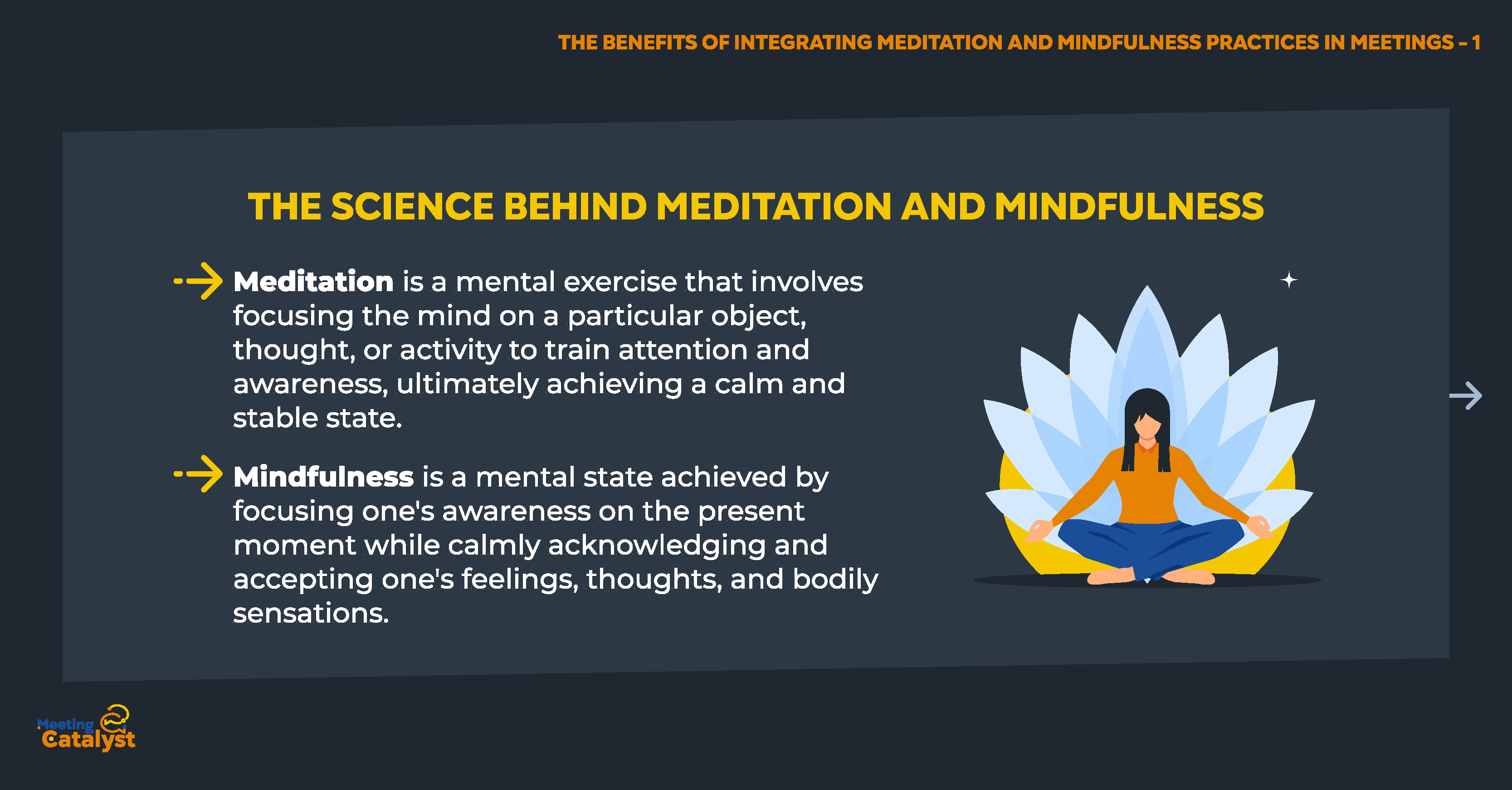
Before we delve into the benefits of incorporating mindfulness practices in meetings, it's essential to understand the science behind these techniques. Meditation and mindfulness have gained traction in recent years due to their proven impact on mental health, cognitive functioning, and overall well-being.
What is Meditation?
Meditation is a mental exercise that involves focusing the mind on a particular object, thought, or activity to train attention and awareness, ultimately achieving a calm and stable state. Various meditation styles, such as concentration meditation and mindfulness meditation, are used worldwide, each offering unique benefits.
What is Mindfulness?
Mindfulness, on the other hand, is a mental state achieved by focusing one's awareness on the present moment while calmly acknowledging and accepting one's feelings, thoughts, and bodily sensations. Mindfulness practices can be integrated into daily life, including work, exercise, and even meetings.
The Science-Backed Benefits
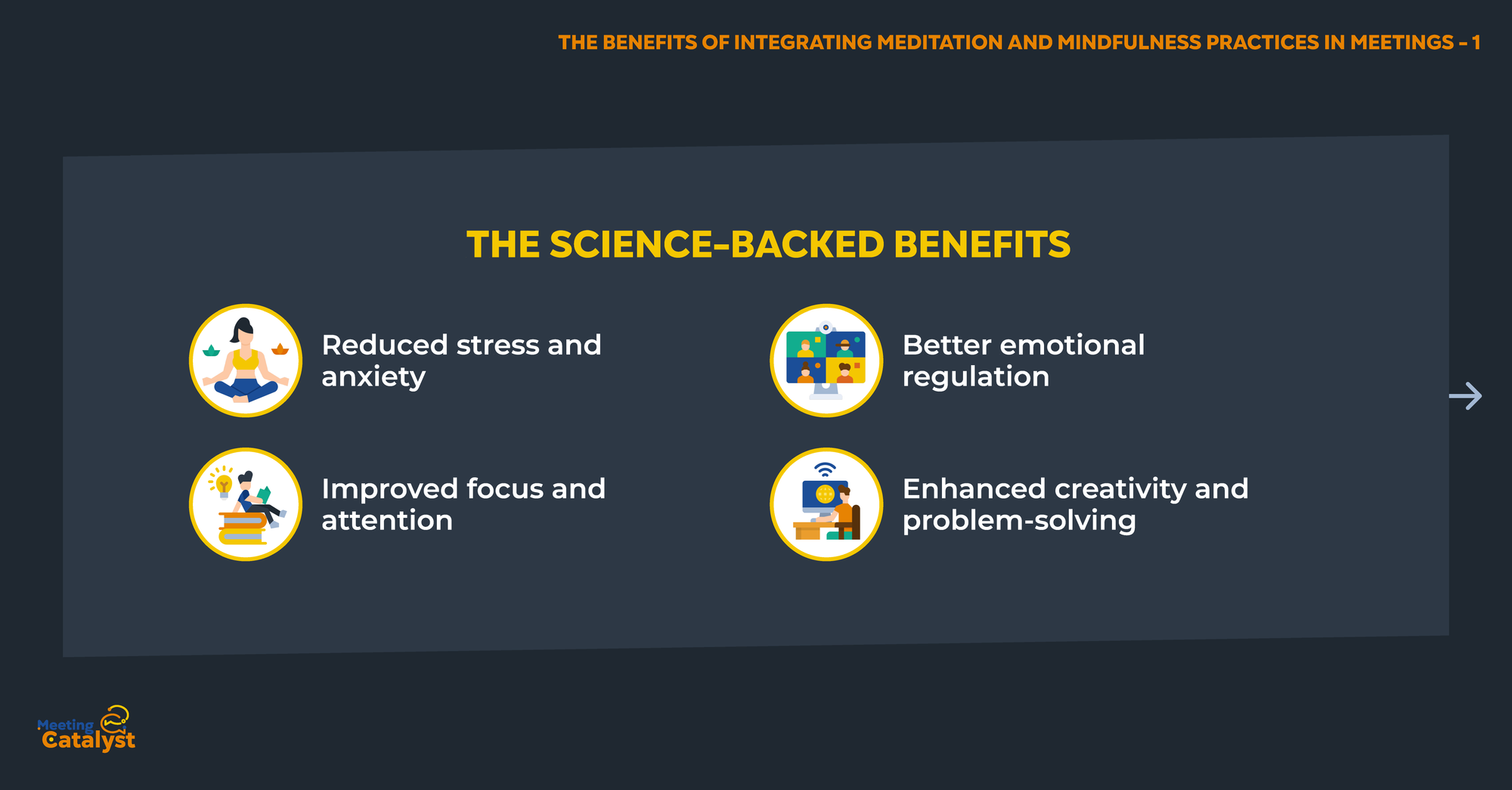
Numerous studies have highlighted the positive effects of meditation and mindfulness on both mental and physical health. Some of the scientifically-backed benefits include:
- Reduced stress and anxiety: Meditation and mindfulness practices can decrease the production of cortisol, the stress hormone, and increase the release of feel-good neurotransmitters, such as serotonin and dopamine.
- Improved focus and attention: Regular practice of mindfulness can enhance attention control, helping individuals concentrate better and avoid distractions.
- Better emotional regulation: Mindfulness practices can increase emotional intelligence, promoting self-awareness, empathy, and adaptability.
- Enhanced creativity and problem-solving: Mindfulness practices can promote divergent thinking, which is essential for generating innovative ideas and solutions.
With this understanding of the science behind meditation and mindfulness, we can now explore their benefits when integrated into meetings, fostering a more productive and supportive work environment.
Implementing Mindfulness and Meditation Techniques in Meetings
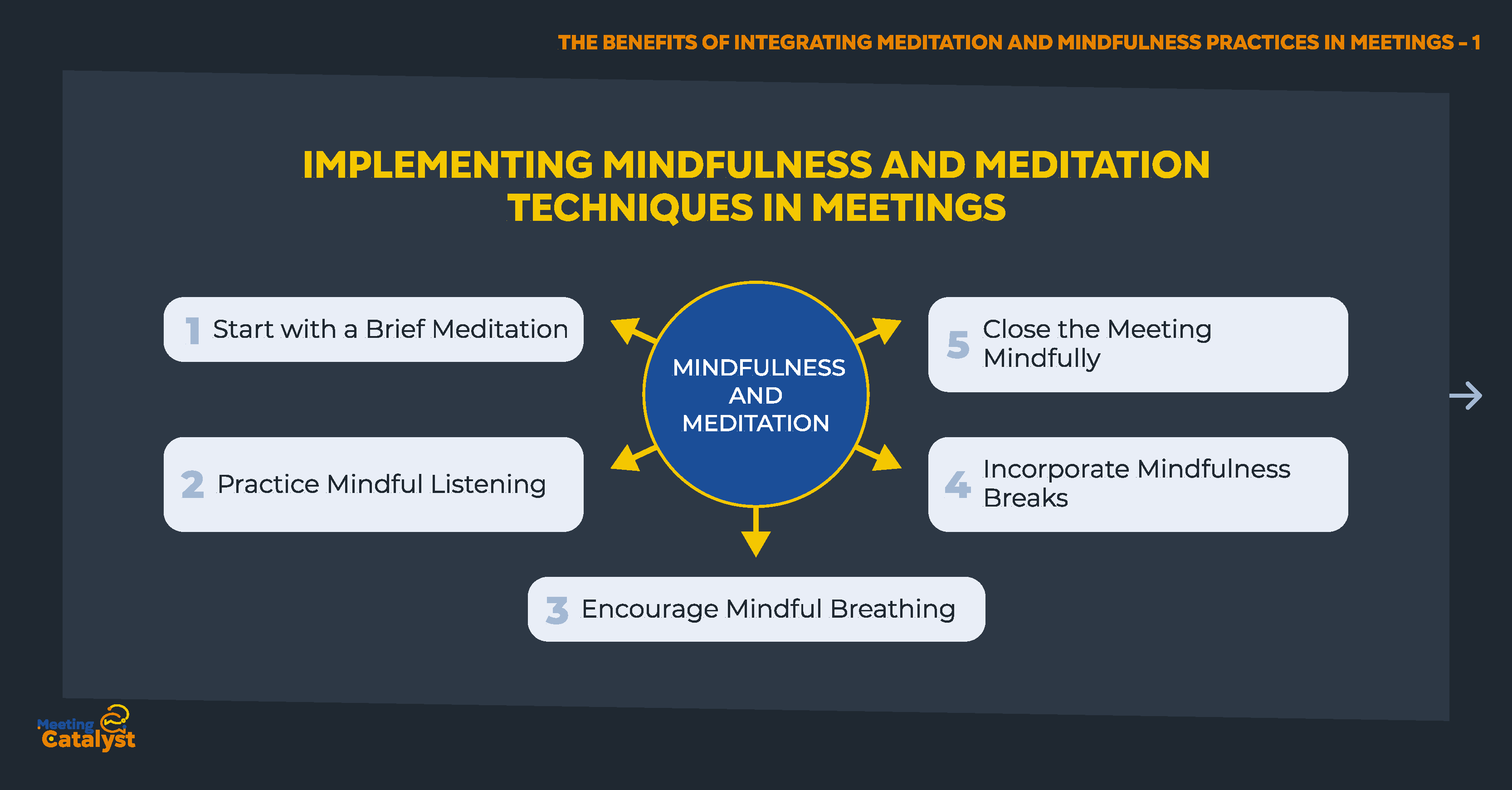
Integrating mindfulness and meditation techniques into your meetings can lead to more focused, engaged, and productive discussions. Here are some practical strategies to bring these practices into your organization's meetings.
1. Start with a Brief Meditation
Kick off your meetings by dedicating a few minutes to guided meditation. This can help participants to:
- Clear their minds and let go of any distractions
- Set their intentions for the meeting
- Foster a sense of unity and collaboration
There are numerous guided meditation apps and resources available, making it easy to find the right fit for your team.
2. Practice Mindful Listening
Encourage meeting attendees to practice mindful listening. This involves:
- Giving full attention to the speaker without interrupting
- Resisting the urge to formulate a response while others are speaking
- Acknowledging and validating others' perspectives
By implementing mindful listening, your team can foster better communication, empathy, and understanding.
3. Encourage Mindful Breathing
Invite participants to engage in mindful breathing exercises during meetings, especially when discussing complex or sensitive topics. This can help attendees to:
- Regulate their emotions
- Maintain focus and clarity
- Reduce stress and anxiety
Simply taking a few deep breaths can make a significant difference in the overall atmosphere of the meeting.
4. Incorporate Mindfulness Breaks
For longer meetings, consider incorporating mindfulness breaks. These short pauses can help attendees to:
- Recharge their mental energy
- Reflect on the discussion so far
- Reconnect with their intentions for the meeting
These breaks can involve stretching, deep breathing, or other mindfulness practices.
5. Close the Meeting Mindfully
End the meeting with a brief mindful wrap-up. This can involve:
- Expressing gratitude for the collaborative effort
- Reflecting on key takeaways and decisions
- Setting intentions for post-meeting tasks
By closing the meeting mindfully, participants can leave with a sense of accomplishment and purpose.
By implementing these mindfulness and meditation techniques, your organization can cultivate a more focused, collaborative, and efficient meeting culture.
Enhancing Collaboration and Team Building with Mindfulness Practices
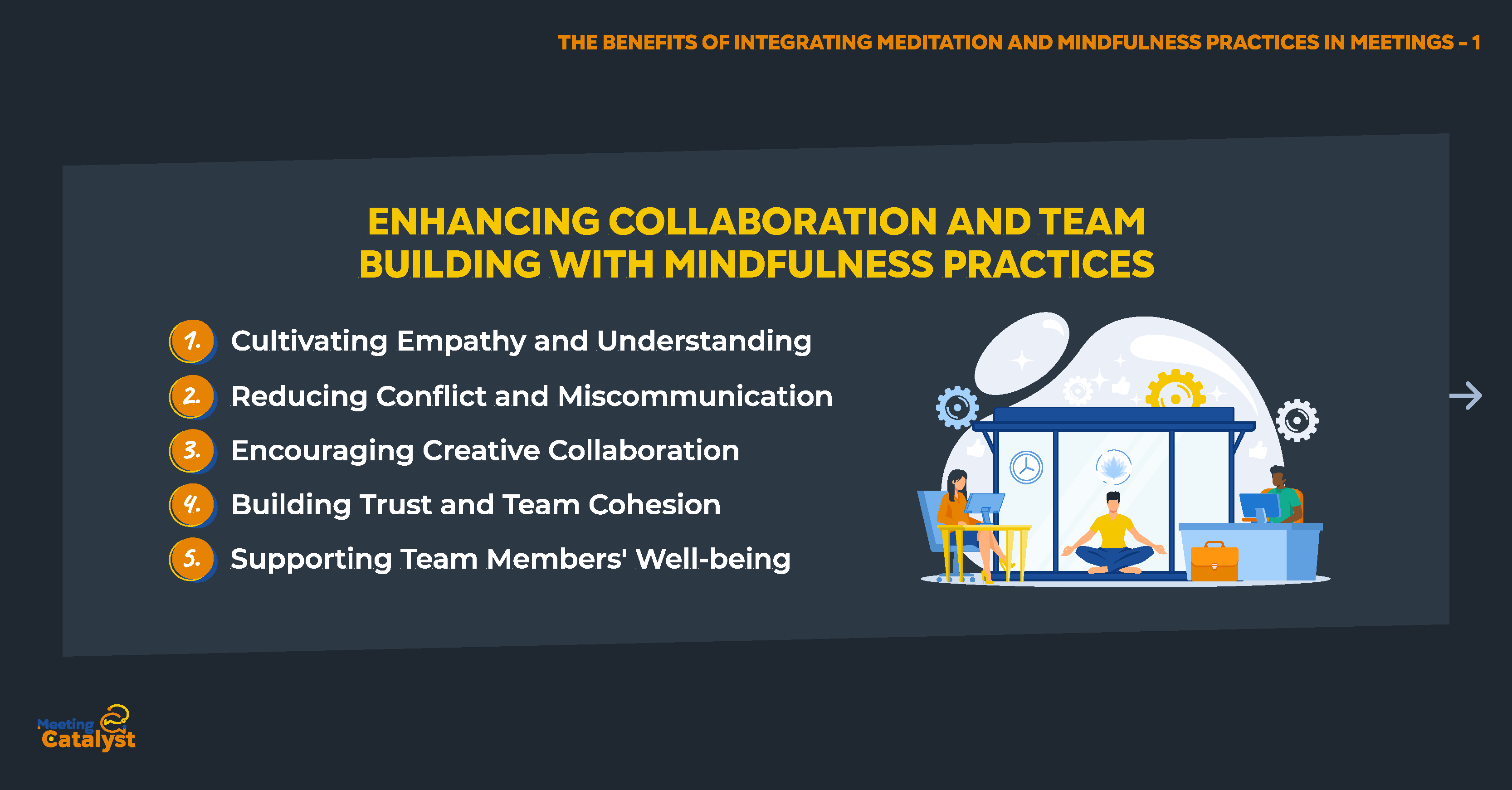
Incorporating mindfulness practices into your meetings not only boosts focus and productivity but also strengthens collaboration and team building. Here are some ways mindfulness can foster a more cohesive and supportive team environment.
1. Cultivating Empathy and Understanding
Mindfulness practices, such as mindful listening and compassionate communication, encourage team members to:
- Be more present and attentive to others' needs
- Develop a deeper understanding of different perspectives
- Build empathy and support for one another
By fostering empathy and understanding, teams can work together more effectively and overcome challenges.
2. Reducing Conflict and Miscommunication
Mindfulness techniques can help reduce conflict and miscommunication within teams by:
- Encouraging open, non-judgmental dialogue
- Promoting active listening and thoughtful responses
- Nurturing emotional intelligence and self-awareness
By practicing mindfulness, team members can resolve conflicts more constructively and maintain a positive group dynamic.
3. Encouraging Creative Collaboration
Mindfulness practices can also support creative collaboration by:
- Creating a non-judgmental atmosphere for idea sharing
- Encouraging mental clarity and focus for problem-solving
- Enhancing the ability to think outside the box
When team members feel safe and supported, they are more likely to contribute innovative ideas and solutions.
4. Building Trust and Team Cohesion
Integrating mindfulness practices in meetings can help build trust and cohesion among team members by:
- Fostering a sense of shared purpose and responsibility
- Encouraging transparency and open communication
- Strengthening interpersonal connections through empathy and understanding
With increased trust and cohesion, teams can work together more efficiently and effectively to achieve their goals.
5. Supporting Team Members' Well-being
Lastly, mindfulness practices can benefit the overall well-being of team members by:
- Reducing stress and burnout
- Enhancing emotional resilience
- Promoting a healthy work-life balance
By caring for the well-being of team members, organizations can create a more engaged, motivated, and productive workforce.
Incorporating mindfulness practices into your meetings can have a profound impact on collaboration, team building, and overall team performance. Start implementing these techniques today to create a more mindful and cohesive work environment.
Promoting Mental Health and Stress Reduction in the Workplace

The benefits of mindfulness and meditation in meetings extend beyond the meeting room, contributing to a healthier and more supportive work environment. By integrating mindfulness practices, organizations can promote mental health and reduce stress in the workplace.
1. Encourage Regular Mindfulness Breaks
Introduce the idea of mindfulness breaks to help employees recharge and refocus throughout the day. Regular mindfulness breaks can:
- Improve concentration and productivity
- Decrease stress and anxiety levels
- Promote mental clarity and decision-making
These breaks can be as simple as taking a few minutes for deep breathing or a short guided meditation.
2. Offer Mindfulness Training and Resources
Invest in mindfulness training and provide resources to help employees develop their mindfulness skills. This can include:
- Workshops or seminars led by mindfulness experts
- Access to mindfulness apps or online courses
- Guided meditation sessions or mindfulness exercises
By offering training and resources, you empower employees to take control of their mental well-being and manage stress more effectively.
3. Create Mindful Spaces
Designate mindful spaces within the workplace where employees can go to practice mindfulness, meditation, or simply find a quiet moment. These spaces can:
- Provide a serene environment for relaxation and reflection
- Encourage employees to take breaks and prioritize self-care
- Demonstrate the organization's commitment to employee well-being
A dedicated space can make it easier for employees to incorporate mindfulness practices into their daily routine.
4. Foster a Supportive and Compassionate Work Culture
Cultivate a work culture that values empathy, understanding, and support. Encourage managers and team leaders to:
- Practice active listening and empathetic communication
- Address mental health concerns proactively and non-judgmentally
- Encourage open dialogue and destigmatize discussions about mental health
By fostering a compassionate work culture, employees will feel more comfortable seeking support and addressing mental health challenges.
5. Monitor Progress and Continuously Improve
Regularly assess the effectiveness of your organization's mindfulness initiatives and make adjustments as needed. This can include:
- Employee surveys or feedback sessions
- Analyzing key performance indicators related to mental health and stress reduction
- Identifying areas for improvement and implementing targeted strategies
By continuously monitoring progress and adapting your approach, you can create a more mindful and mentally healthy work environment for all employees.
Incorporating mindfulness and meditation practices in meetings and the broader workplace can have a significant impact on employee mental health and stress reduction. By promoting these practices, organizations can create a more supportive, resilient, and engaged workforce.
Boosting Productivity and Focus in Meetings
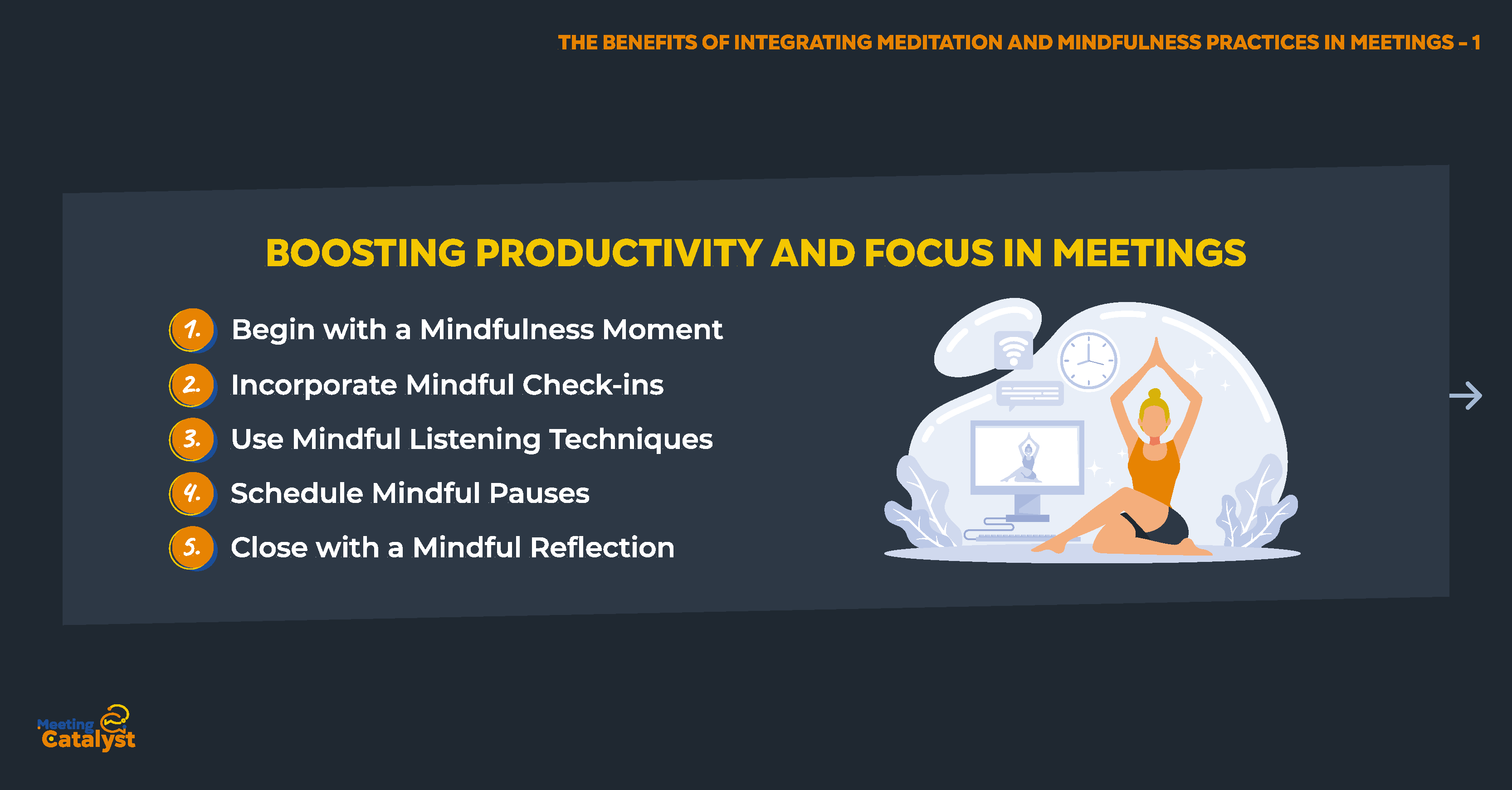
Mindfulness and meditation practices can also have a direct impact on meeting productivity and focus. By integrating these techniques, organizations can maximize the efficiency of meetings and help participants stay fully engaged throughout the session.
1. Begin with a Mindfulness Moment
Starting your meeting with a mindfulness moment can help attendees transition from their busy workday and arrive fully present in the meeting. This brief practice can:
- Clear mental clutter and improve focus
- Encourage active listening and open-mindedness
- Set a positive tone for the meeting
A mindfulness moment might include a few deep breaths, a guided visualization, or a short body scan to help attendees tune in to the present moment.
2. Incorporate Mindful Check-ins
Introduce mindful check-ins at the beginning of meetings to encourage self-awareness and authentic communication. During a mindful check-in, participants can:
- Share their current emotional state or mindset
- Express any concerns or distractions they're experiencing
- Connect with their colleagues on a deeper level
By fostering open communication and empathy, mindful check-ins can create a more supportive meeting environment and enable more effective collaboration.
3. Use Mindful Listening Techniques
Encourage attendees to practice mindful listening during meetings to enhance focus and understanding. Mindful listening techniques can:
- Improve comprehension and retention of information
- Reduce misunderstandings and miscommunications
- Strengthen relationships and trust among team members
To practice mindful listening, attendees can focus on being fully present, avoiding judgment, and providing their full attention to the speaker.
4. Schedule Mindful Pauses
Incorporate mindful pauses throughout the meeting to help maintain focus and prevent fatigue. Mindful pauses can:
- Give attendees a chance to recharge and refocus
- Encourage reflection on the information presented
- Prevent information overload and decision fatigue
These pauses might include a brief moment of silence, a deep breathing exercise, or a quick stretch to re-energize the body and mind.
5. Close with a Mindful Reflection
End the meeting with a mindful reflection to help attendees process the information and solidify key takeaways. This practice can:
- Reinforce key points and decisions made during the meeting
- Encourage attendees to reflect on their contributions and insights
- Set the stage for continued collaboration and progress
A mindful reflection might involve a brief discussion of the meeting highlights or a guided visualization of the team's goals and objectives.
By integrating meditation and mindfulness practices into meetings, organizations can boost productivity and focus, leading to more efficient and effective collaboration among team members.
Adapting Mindfulness Techniques for Remote and Hybrid Meetings
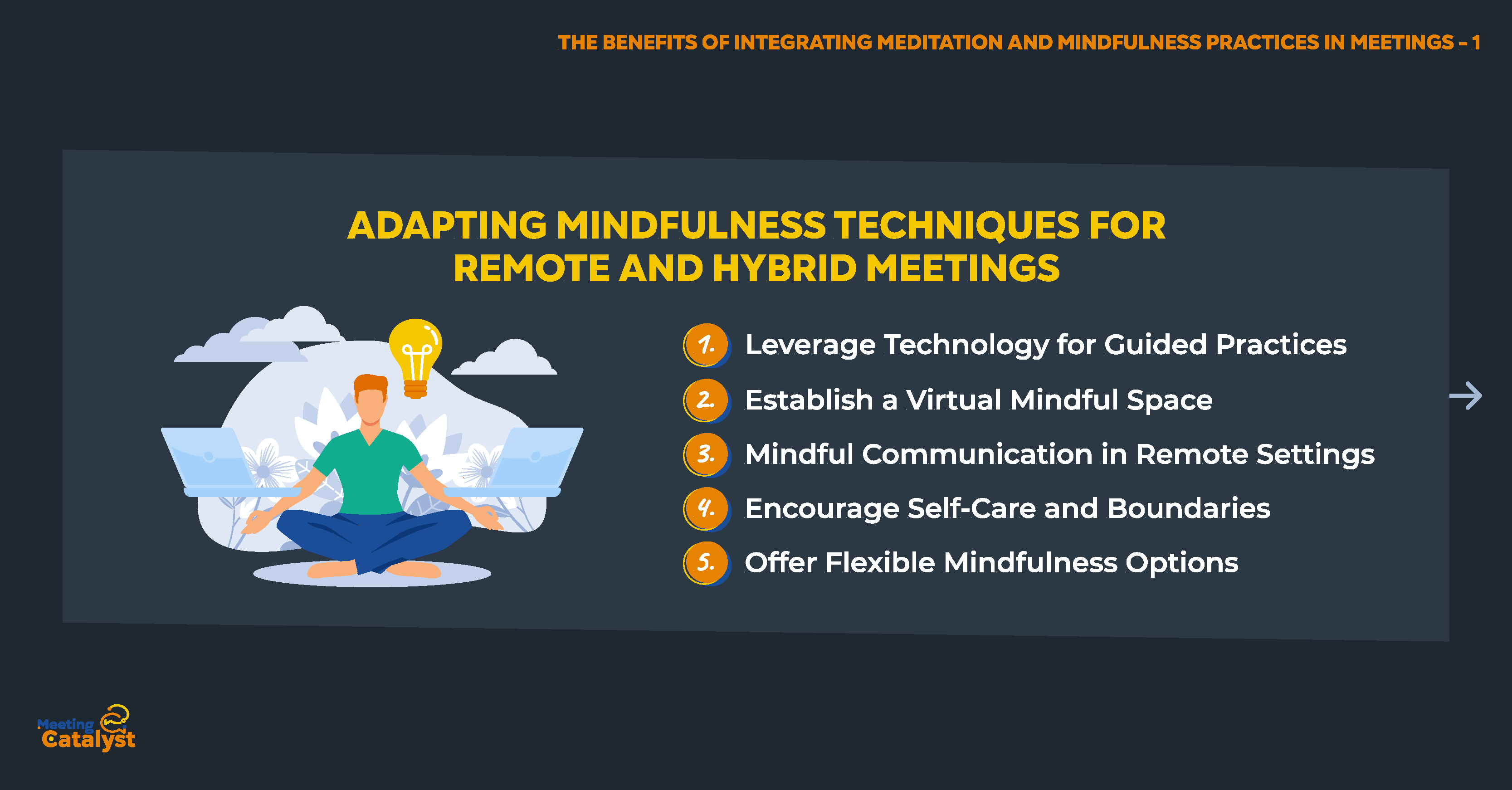
With remote and hybrid work environments becoming more prevalent, it's crucial to adapt mindfulness techniques to suit these settings. By implementing mindfulness practices in remote and hybrid meetings, organizations can ensure that all team members benefit from increased focus, collaboration, and well-being.
1. Leverage Technology for Guided Practices
Utilize technology to facilitate guided mindfulness practices for remote and hybrid teams. This can:
- Ensure consistent guidance for all team members, regardless of location
- Facilitate a shared experience, promoting unity and connection
- Offer easy access to resources, such as guided meditations or mindfulness apps
Consider using video conferencing tools, screen sharing, or shared playlists to lead remote and hybrid team members through mindfulness exercises.
2. Establish a Virtual Mindful Space
Create a dedicated virtual mindful space where remote team members can engage in mindfulness practices together. This can:
- Encourage regular mindfulness practice among remote team members
- Foster a sense of community and shared experience
- Provide a space for team members to seek support and encouragement
This virtual space might be a dedicated chat room, a video conference room, or a shared online document for journaling and reflection.
3. Mindful Communication in Remote Settings
Promote mindful communication among remote and hybrid team members by:
- Encouraging active listening and empathy during virtual meetings
- Offering training in mindful communication techniques, such as paraphrasing and reflecting
- Implementing tools and practices that support clear and open communication, like asynchronous updates and regular check-ins
4. Encourage Self-Care and Boundaries
Help remote and hybrid team members maintain self-care and healthy boundaries by:
- Encouraging regular breaks and self-care practices during the workday
- Providing resources and support for mental health and well-being
- Modeling healthy work-life balance and boundaries for team members
5. Offer Flexible Mindfulness Options
Provide flexible mindfulness options for remote and hybrid team members, such as:
- Offering a variety of mindfulness practices to suit different preferences and schedules
- Providing on-demand resources for team members to access at their convenience
- Encouraging team members to personalize their mindfulness routines to suit their individual needs
By adapting mindfulness techniques for remote and hybrid meetings, organizations can foster a more focused, collaborative, and supportive work environment, regardless of where team members are located.
Conclusion
Integrating meditation and mindfulness practices in meetings can significantly transform the work environment by promoting mental health, reducing stress, enhancing collaboration, and boosting productivity. As more companies recognize the value of these practices, they are increasingly incorporating them into their meeting culture and organizational strategies.
By implementing mindfulness and meditation techniques in meetings, you can foster a more engaged, focused, and healthy workforce. Adapting these techniques for remote and hybrid meetings ensures that all team members can benefit from these practices, regardless of their work location.
Integrating meditation and mindfulness practices in meetings leads to a more harmonious and efficient work environment. By embracing these practices, your organization can cultivate a culture of well-being, collaboration, and high performance.